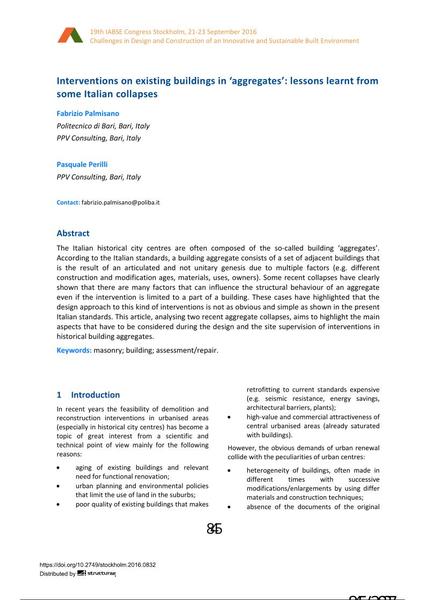Interventions on existing buildings in ‘aggregates’: lessons learnt from some Italian collapses

|
|
|||||||||||
Bibliografische Angaben
| Autor(en): |
Fabrizio Palmisano
(Politecnico di Bari, Bari, Italy PPV Consulting, Bari, Italy
)
Pasquale Perilli (PPV Consulting, Bari, Italy) |
||||
|---|---|---|---|---|---|
| Medium: | Tagungsbeitrag | ||||
| Sprache(n): | Englisch | ||||
| Tagung: | IABSE Congress: Challenges in Design and Construction of an Innovative and Sustainable Built Environment, Stockholm, Sweden, 21-23 September 2016 | ||||
| Veröffentlicht in: | IABSE Congress Stockholm, 2016 | ||||
|
|||||
| Seite(n): | 845-852 | ||||
| Anzahl der Seiten (im PDF): | 8 | ||||
| Jahr: | 2016 | ||||
| DOI: | 10.2749/stockholm.2016.0832 | ||||
| Abstrakt: |
The Italian historical city centres are often composed of the so-called building ‘aggregates’. According to the Italian standards, a building aggregate consists of a set of adjacent buildings that is the result of an articulated and not unitary genesis due to multiple factors (e.g. different construction and modification ages, materials, uses, owners). Some recent collapses have clearly shown that there are many factors that can influence the structural behaviour of an aggregate even if the intervention is limited to a part of a building. These cases have highlighted that the design approach to this kind of interventions is not as obvious and simple as shown in the present Italian standards. This article, analysing two recent aggregate collapses, aims to highlight the main aspects that have to be considered during the design and the site supervision of interventions in historical building aggregates. |
||||
| Stichwörter: |
Mauerwerk Gebäude
|
||||
